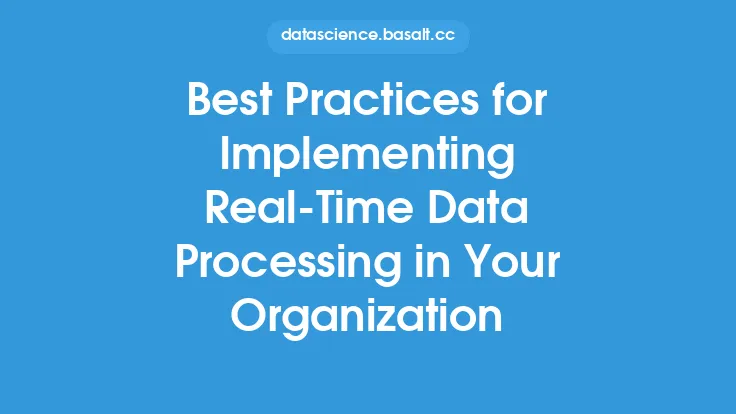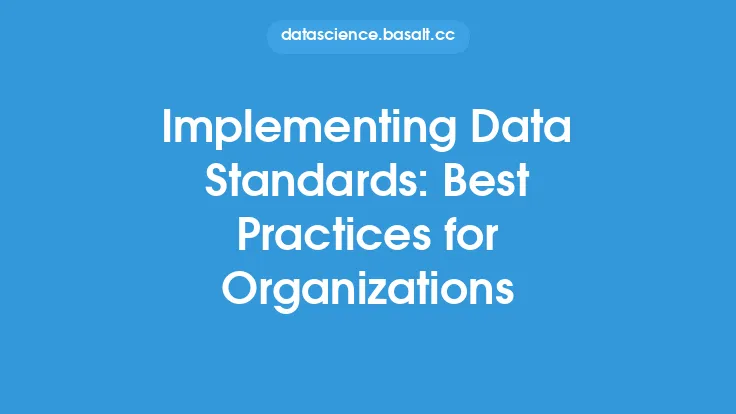Implementing anomaly detection effectively requires a combination of understanding the data, selecting the appropriate techniques, and fine-tuning the models. Anomaly detection is a critical component of data mining, as it enables the identification of unusual patterns or outliers that may indicate errors, fraud, or other significant events. To ensure successful implementation, several best practices should be followed.
Data Preparation
Data preparation is a crucial step in anomaly detection. It involves cleaning, transforming, and formatting the data to make it suitable for analysis. The quality of the data has a significant impact on the accuracy of the anomaly detection model. Therefore, it is essential to handle missing values, remove duplicates, and perform data normalization. Data normalization is particularly important, as it helps to prevent features with large ranges from dominating the model. Additionally, data transformation, such as converting categorical variables into numerical variables, may be necessary to ensure that the data is in a suitable format for the chosen anomaly detection technique.
Choosing the Right Technique
The choice of anomaly detection technique depends on the nature of the data and the type of anomalies that are expected to occur. For example, statistical methods, such as the Z-score method and the Modified Z-score method, are suitable for detecting anomalies in normally distributed data. On the other hand, machine learning approaches, such as One-Class SVM and Local Outlier Factor (LOF), are more effective for detecting anomalies in complex datasets. It is also important to consider the computational resources and the size of the dataset when selecting a technique. For instance, some techniques, such as density-based methods, may be computationally expensive and may not be suitable for large datasets.
Model Evaluation
Evaluating the performance of an anomaly detection model is critical to ensure that it is effective in detecting anomalies. Common evaluation metrics include precision, recall, and F1-score. However, these metrics may not be suitable for imbalanced datasets, where the number of anomalies is significantly smaller than the number of normal instances. In such cases, alternative metrics, such as the area under the receiver operating characteristic (ROC) curve and the area under the precision-recall curve, may be more appropriate. It is also essential to consider the cost of false positives and false negatives when evaluating the model. For example, in a fraud detection system, a false positive may result in a legitimate transaction being blocked, while a false negative may result in a fraudulent transaction being approved.
Model Tuning
Model tuning is an essential step in anomaly detection, as it enables the optimization of the model's parameters to achieve the best possible performance. The choice of hyperparameters, such as the threshold value and the number of nearest neighbors, can significantly impact the model's performance. Grid search and random search are common techniques used for hyperparameter tuning. However, these techniques can be computationally expensive and may not be suitable for large datasets. Alternative techniques, such as Bayesian optimization and gradient-based optimization, may be more efficient and effective.
Handling Imbalanced Datasets
Imbalanced datasets, where the number of anomalies is significantly smaller than the number of normal instances, can pose a significant challenge in anomaly detection. Common techniques for handling imbalanced datasets include oversampling the minority class, undersampling the majority class, and generating synthetic samples. However, these techniques may not always be effective and may introduce bias into the model. Alternative techniques, such as cost-sensitive learning and ensemble methods, may be more effective in handling imbalanced datasets.
Real-World Considerations
Anomaly detection is not just a technical problem but also a business problem. It is essential to consider the real-world implications of anomaly detection, such as the cost of false positives and false negatives, the potential impact on customers, and the regulatory requirements. For example, in a healthcare setting, a false positive may result in a patient being misdiagnosed, while a false negative may result in a patient not receiving timely treatment. Therefore, it is crucial to involve domain experts and stakeholders in the development and deployment of anomaly detection systems.
Model Interpretability
Model interpretability is critical in anomaly detection, as it enables the understanding of why a particular instance was classified as an anomaly. Techniques, such as feature importance and partial dependence plots, can be used to interpret the model's decisions. However, these techniques may not always be effective, and alternative techniques, such as SHAP values and LIME, may be more suitable. Model interpretability is essential in building trust in the model and ensuring that the anomalies detected are meaningful and actionable.
Model Maintenance
Anomaly detection models are not static and require ongoing maintenance to ensure that they remain effective. The data distribution may change over time, and the model may need to be retrained or updated to adapt to these changes. Additionally, the model's performance may degrade over time due to concept drift or other factors. Therefore, it is essential to monitor the model's performance continuously and update the model as necessary. Techniques, such as online learning and incremental learning, can be used to update the model in real-time.
Conclusion
Implementing anomaly detection effectively requires a combination of technical expertise, domain knowledge, and real-world considerations. By following best practices, such as data preparation, choosing the right technique, model evaluation, model tuning, handling imbalanced datasets, and model interpretability, organizations can develop effective anomaly detection systems that provide meaningful and actionable insights. Ongoing model maintenance is also critical to ensure that the model remains effective over time. By leveraging anomaly detection, organizations can identify unusual patterns and outliers, reduce risks, and improve decision-making.





